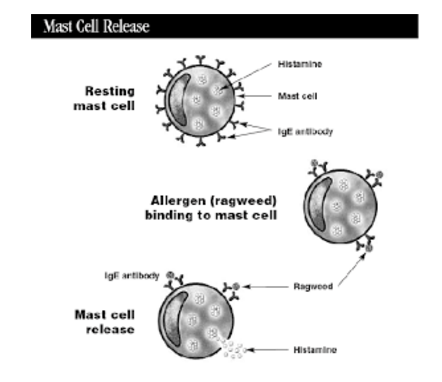Best Allergy Doctor in Philly
Allergy Symptoms & Reactions
Do you love spring yet have itchy eyes, constant sneezing, or congestion? Have pets, yet always need a tissue when they are around? Allergies may be the root of all your symptoms, and can affect anything from your nose, eyes, throat, eyes, skin, chest, or even your GI track!
Allergies are often mis-diagnosed with other non-allergic conditions but with proper diagnosis and customized treatment, the allergists at The Asthma Center can help you fell better and get relief!
Below is a quick guide to allergies. For a more in depth analysis, check out the Understanding Sinusitis and Allergy Manual published by The Asthma Center Education and Research Fund, available here.
Allergies: The Technical Mechanism of Allergic Reactions
Unique, chemically rich mast cells line the mucous membranes of the nose, sinuses and lungs ready to release histamine and other chemical mediators (leukotriene, tryptase, etc.), which can cause inflammation of the nose, sinus and bronchial tubes. In allergic reactions, the allergy anibody, IgE, serves as the bridge between allergic substances and the mast cells. When allergens blind to IgE on the mast cell surface, they release chemicals. In other circumstances, mast cells release their chemicals without an allergic trigger (for example, following a cold.) The effects of mast cell mediator release depend on where the reaction occurs. For example, if mast cell release occurs in the eye, you will experience the symptoms of eye allergies (allergic conjunctivitis); if release occurs in the nose or sinuses, you will experience the symptoms of hayfever (allergic rhinitis) and possibly sinus pressure; in the reaction occurs in the lungs, you will experience asthma symptoms. If your mast cell reactions occur in your skin, you can experience severe hives, and/or angioadema. The inflammation in these different areas is all due to accumulation of various cells (eosinophils, neutrophils, lymphocytes, macrophages, etc.), swelling (edema) and increased mucous production.

Environmental Airborne Allergens
Allergens are particles, usually composed of proteins, capable of causing an allergic response. These particles are often airborne in indoor and outdoor environments and are generally very small and not visible to the naked eye. Indoor allergens tend to be present throughout the year, whereas outdoor allergens tend to be present only during specific seasons. You should be aware of the allergens in your environment and whether you are allergic to them. This awareness can help you avoid relevant allergens, plan outdoor activities and choose appropriate treatment options. In some cases, allergy immunotherapy may be recommended.
Outdoor Allergies: What Our Allergy Doctors See in Philly
Outdoor airborne allergens, also known as seasonal allergens, are chiefly present in the air in the Delaware Valley during the spring, summer and fall seasons. They include tree pollen, grass pollen, weed pollen and mold spores. Tree and grass pollen predominate during the spring season. Weed pollen predominates during the late summer and early fall. Mold spores tend to be present in significant levels throughout the warmer weather months and decline in colder weather.
Pollen and mold spore levels in the outdoor environment in Philadelphia and southern New Jersey are monitored with sophisticated collection instruments by the specialists at The Asthma Center from March through October each year. The Asthma Center has been operating a pollen and mold spore monitoring station in the Delaware Valley since 1992, certified by the American Academy of Allergy, Asthma, and Immunology through its National Allergy Bureau. Our pollen studies have been published in national allergy journals and serve as the basis for allergy testing for all allergists in the metropolitan Philadelphia area. Our studies have defined the significant pollen seasons, when the seasons start, peak and how long they last. Air samples are measures in two locations: Center City, Philadelphia and Cherry Hill, NJ. Published studies by The Asthma Center physicians have shown striking similarities between urban (Philadelphia) and suburban (Cherry Hill) pollen and mold spore counts, which are reported on this website, and The Asthma Center’s Facebook page. These counts are also provided to the National Allergy Bureau and local newspapers.
Pollen & Mold Calendar

Tree Pollen
Tree pollen is produced by a wide variety of tree species as a means of reproduction during the spring season. Effective pollination depends on the transport of these particles by wind currents. Our data indicates that the local spring tree season begins in early March and extends through May. The most common groups of tree pollen measured in our area include juniper, cedar, maple, elm, oak, birch, pine, and mulberry. Minor tree pollen groups include alder, ash, walnut, sweet gum, sycamore, poplar, willow, and linden. Individual trees pollinate for two- to three-week intervals, but not necessarily at the same time. These intervals overlap most often in the spring. Also, changes in weather can extend the pollen season.
Grass Pollen
Grass pollen, similar to tree pollen, is produced by a variety of grass species as a means of reproduction during the spring season. Effective pollution depends on the transport of these particles by wind currents. In the Delaware Valley, airborne grass pollen typically appears in early April, peaks throughout the month of May and gradually declines during June. Early May is a particularly difficult time for seasonal allergy sufferers as both tree and grass pollen is at peak levels. A second, less intense burst of grass pollen typically seen in the Delaware Valley include Kentucky, orchard, rye and Timothy.
Weed Pollen
Weed pollen is produced by a wide variety of weed species as a means of reproduction during the late summer and early fall seasons. A few species also produce pollen during the early and midsummer seasons. Effective pollination depends on the transport of these particles by wind currents. In the Delaware Valley, weed pollen typically appears in early August, peaks in late August and early September and gradually declines in late October. Ragweed is the most dominant weed pollen in the local area; other common types of weed pollen include English Plantain, Lamb’s Quarters, Sheep Sorrel and Sage.
Molds
Molds, also known as fungi, produce spores and other fungal particles which are airborne in abundant numbers during the warmer weather months. In the Delaware Valley, molds first appear in early spring and persist throughout the summer and fall seasons. Mold counts are usually significantly reduced during winter months, reaching their lowest levels with snow cover. There is no true peak to the mold season, though the highest levels have generally been observed during the midsummer to late fall. The majority of mold spores and other fungal particles in the air are unable to be identified due to their small size and lack of distinctive characteristics. The most dominant identifiable types of molds in the local area include Alternaria, Cladosporium, Basidiospores, Ascospores, and Epicoccum.
Indoor Allergens
Indoor allergens, also known as perennial allergens, are generally present in the indoor environment throughout the year with no significant seasonal variation. These allergens have taken on an increased importance over recent decades as a result of a pattern of increased time spent indoors and improved home construction with better insulation which has fostered greater exposure. The mixture of perennial allergens found in a specific indoor environment is determined by climate, season, altitude, the presence of pets, rodents, and cockroaches. An unusual indoor allergen may be peculiar to a particular environment; for example, airborne flour in a bakery. The major indoor allergens in metropolitan Philadelphia and southern New Jersey include dust mite allergens, cat allergens, dog allergens, cockroach allergens and mold spores and other fungal elements.
Dust Mite Allergens
Dust mites (Dermatophagoides pteronyssinus and Dermatophagoldes farina) represent a major source of indoor allergens in the Delaware Valley and in many parts on the world. They are dependent on high ambient humidity (greater than 50%) and have an optimal growth temperature from 65 degrees to 80 degrees Fahrenheit. Dust mites are found chiefly in carpets, pillow, mattresses, bedding, upholstered furniture, draperies and stuffed animals. These organisms are microscopic and cannot be seen by the naked eye.
The actual allergenic proteins produced by dust mites are believed to be digestive enzymes which are excreted in fecal particles. Little or no dust mite allergen is airborne in undisturbed conditions but rather requires a disturbance, such as vacuuming, to produce significant airborne levels for relatively short periods of time. You have your most intimate encounters with dust mites when your nose, eyes, and skin are in close contact with pillow, blankets, mattresses, carpeting and upholstered furniture.
Cat and Dog Allergens/Animal Dander
Cat and dog allergens are major indoor allergens in homes and private cars where cats and dogs are present. The main cat allergen is a protein found in the skin, saliva and urine. Cats produce other allergens as well, such as cat albumin, which are of much less clinical importance.
Cat allergen can be airborne in an indoor environment even in undisturbed condition. This explains how you may experience an acute onset of allergic symptoms upon entering a home with a cat without any obvious disturbance. Cat and dog allergens are both small particles that remain airborne for long periods of time.
Cockroach Allergens
Cockroach has been recognized as a major source of indoor allergen in some urban environments. Several species of cockroaches are common in houses, with the best known being the German cockroach and the American cockroach. German cockroaches are common in cities in the United States, particularly in inner city apartments. Many individuals who live in crowded, poorly cleansed areas have cockroach allergy.
The four chief German cockroach allergens are found in feces, saliva, and of the outside surfaces of cockroaches. Similar to dust mites, little or no cockroach allergen is airborne in undisturbed conditions. Cockroach allergen becomes airborne for short periods of time following a disturbance such as vacuuming.
Other animals may also play a role in producing allergy symptoms. In urban and rural envrionments, rodent dander may be a relevant exposure. Some people with gerbils and rabbits as pets, or have exposure to these animals, may develop allergies to the animals.
Indoor Mold Allergens
Mold allergens associated with mold spores and other fungal elements can be a major source of indoor allergens, particularly in home where damp or wet areas exist. Areas of mold growth are often difficult to detect, hiding under floors or behind walls. The mixture of mold spores seen indoors includes Penicillium, Aspergillus, and Cladosporium. Unique molds like Stachybotrys may be found in some indoor settings where extensive water damage has occurred. If molds are suspected, special culture techniques and air sampling specimens may be done. A thorough inspection may be required by experts in environmental contamination and mold removal.
There have been many claims made about associations between damp environments and health effects. Possible reasons for these connections include: allergic reactions, direct irritation by fungal mold elements, toxins released from molds (Aspergillus, Fusarium, Penicillium, Stachybotrys): volatile organic compounds (VOCs), or other immune responses stimulated by mold. Individuals with damp environments often present with symptoms of congestion, cough, mucous discharge, headache, shortness of breath, eye itching, dizziness, restless legs, fatigue and abdominal pain. Most individuals with exposure to mold contaminates do not have typical allergic symptoms. Whether all indoor molds produce health problems beyond allergic reactions is still widely debated. Therefore the presence of mold or mold derived toxins in an indoor environment does not necessarily mean there are associated effects on health.












